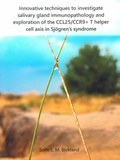Innovative techniques to investigate salivary gland immunopathology and exploration of the CCL25 / CCR9+ helper cell axis in Sjögren's syndrome

Blokland, Sofie
- Promoter:
- Prof.dr. T.R.D.J. (Timothy) Radstake
- Co-promoter:
- Dr. A.A. (Aike) Kruize & dr. J.A.G. (Joël) van Roon
- Research group:
- Radstake
- Date:
- October 4, 2018
- Time:
- 10:30 h
Summary
Sjögren’s syndrome (SjS) is a chronic, systemic autoimmune disorder characterized by dryness of mainly the eyes and mouth in association with lymphocytic infiltration of the exocrine glands. In addition to the dryness symptoms, most patients with SjS suffer from fatigue, arthralgia and myalgia. Part of the patients develop extraglandular manifestations including involvement of for instance the lungs, nervous system, kidneys or skin. Importantly, SjS patients have an increased risk of developing non-Hodgkin lymphoma. Salivary gland biopsy to investigate the presence of lymphocytic infiltration plays an important role in SjS diagnosis.
In this thesis, we explored two innovative techniques to study SjS salivary gland immunopathology. A large amount of soluble inflammatory mediators are detectable in salivary gland biopsy supernatants (termed ‘secretomes’). In the future, this may be extended to markers of epithelial (dys)function and possibly dryness and fatigue, the key complaints of SjS patients. Some of these mediators that were elevated in the secretomes of SjS patients correlated with disease parameters including lymphocytic focus scores (the amount of lymphocytic infiltration) and have previously been linked to lymphoid neogenesis (formation of lymphoid structures). Hence this assay may appear to be of value to predict disease outcome as LFS and lymphoid neogenesis have been linked to lymphoma development. Future studies should reveal its potential in this respect. This also holds true for ‘epigenetic cell counting’ (ECC), which appeared to easily and robustly quantify several immune cell types in salivary glands of SjS and other sicca (dryness) patients. Both techniques may contribute to patient stratification in research and to diagnostics and prognostics in clinical practice in the future. Combination of multiple layers of molecular information (secretome, epigenetic cell counting, RNA sequencing) may not only facilitate increased understanding of immunopathology but also patient-tailored therapeutic approaches. Importantly, ECC may contribute to more standardized analysis of salivary gland biopsies, which is currently lacking within and between hospitals.
In the second part, the potential role of CCR9+ pathogenic T helper cells in SjS immunopathology was studied. The CCR9+ Th cell subset is recently described and shares features with T follicular helper cells including production of IL-21 and ICOS and Bcl-6 expression but displays the chemokine receptor CCR9, and not CXCR5. These cells are therefore called “Tfh-like” cells. In mice and humans, CCR9+ Th cells are present in secondary lymphoid organs. They migrate to mucosal sites in response to the chemokine CCL25. CCR9+ Th cells play key roles in maintenance of mucosal immune homeostasis but are also involved in mucosal inflammation, potentially contributing to inflammatory bowel disease. This thesis identified, in addition to T follicular helper-like characteristics, elevated levels of CCL25 and elevated numbers of CCR9+ cells in salivary glands of SjS patients. In addition, by RNA sequencing novel pathogenic features of CCR9+ T helper cells are identified, that help to understand their pathogenic role in SjS. Considering their important role in mucosal tissues and their capacity to induce Sjögren’s like disease in mice this further supports the notion that targeting of CCR9+ Th cells may have therapeutic potential.